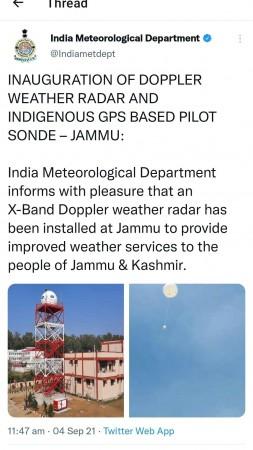An X-band doppler weather radar has been installed to provide improved weather services to the people of Jammu and Kashmir. This information was shared by the India Meteorological Department on Saturday.
Union Minister Dr. Jitendra Singh will formally dedicate the radar along with an indigenous GPS-based pilot-sonde to the public at the meteorological office in Jammu on Sunday. Installation of this band will enhance the capability to detect and track weather.
As per India Meteorological Department, the state-of-the-art indigenous GPS-based pilot-sonde helps to gather data in all weather conditions with minimum human intervention and has facilities of auto-detection of balloon launch and the balloon burst. The new radar will help in providing a nowcast (very short range forecast up to three hours) for all types of severe weather events affecting the region, especially thunderstorms, lightning, squall, and heavy rain.

System to help pilgrims of Mata Vaishno Devi
The India Meteorological Department (IMD) said the system will also help in providing weather forecasts for different sectors, including tourism forecasts for pilgrims of Mata Vaishno Devi shrine at Katra which has an average footfall of 8.5 million every year.
It will also provide inputs to numerical weather prediction models for generating better weather forecasts. In conjunction with data from other sensors such as satellites and automated weather stations, better forecasts and warnings can be achieved leading to minimal loss of property and life, thus providing better services towards public safety and socio-economic benefits.

10 doppler radars for Himalayan region
As per reports, out of the 10 sanctioned doppler radars for the Himalayan region, four will come up in Jammu and Kashmir; Himachal Pradesh and Uttarakhand will get three each. These radars once operational will track and help forecasters issue weather alerts during severe weather events like floods, lightning, thunderstorm which harm life and property.
"IMD has also ambitious plans in improving its nowcasting (forecast issued every four to six hours) as scientists are working towards developing weather models having a range of 1 km or even less," reports said.
On an operational basis, IMD maintains a frequency of six-hourly data assimilation. However, the demand is now for a greater lead time. Now with more radars coming up, we would be able to generate and disseminate weather warnings more effectively.
India's meteorological department has a vast network of upper air observatories comprising 56 Radiosonde/ Radiowind and 62 Radiowind observatories. The Radiowind observatories are meant for the collection of wind speed and wind direction data at different levels in the atmosphere for weather forecasting.









